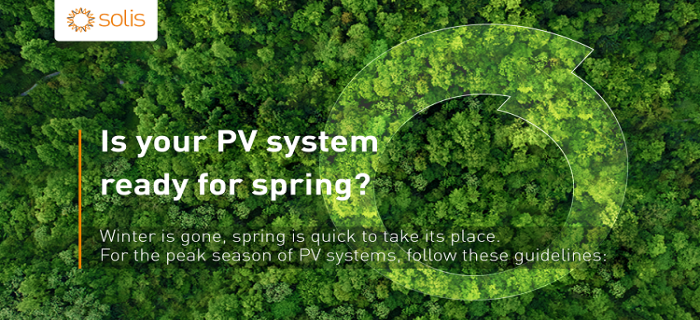
Is your PV system ready for spring?
27 Feb 2023
Q1: Why is spring the peak season for PV systems?
There is a general belief that summer is the peak season for PV, but user data shows that the peak energy is generated in some areas in spring.This is because the power generation of PV systems is determined by a number of factors. In addition to solar radiation, environmental temperature, visibility, and the timing of rain and sunshine are also crucial. In spring, the temperature is suitable, the air cloud layers are relatively thin, the visibility is high, and the sunlight penetration is stronger. Moreover, there is less rain, so the power generation in spring is relatively higher.
Q2: Regular cleaning is essential for increased output in spring. What are the precautions?
I. Clean your system in the morning or in the evening rather than during the middle of the day, which includes the optimal working hours of your system when there is high voltage and current.
II. Keep machines well maintained and protected from damage, and pay attention to personnel safety.
III. Clean at intervals such as once or twice a month, or more frequently in bad weather.
Q3: What are the precautions in thunderstorms?
I. Check that the drain of the PV system is unobstructed. If not, clear it in time to prevent water accumulation in your system.
II. Check the condition, insulation, and sealing of electrical equipment.
III. Provide lightning rods within specified bounds of the PV array to improve the lightning protection grade of the system.
IV. To avoid lightning strikes or induction thunder problems, if there are metal facilities nearby such as solar water heaters, water tanks, or satellite pots, then lightning protection or a cleaning should be done.
Q4: How do you guard against mountain fires during spring?
I. Strengthen management by regularly removing or trimming weeds and green vegetation in and around the power generation area. Make sure to always raise fire safety awareness.
II. Provide full-time safety officers and firefighters for regular inspection of the site.
III. Implement emergency management in daily life, ensure proper planning and patrol arrangement, improve fire safety awareness and emergency response-ability, and avoid secondary accidents.
Q5: What are the precautions on windy days, especially in coastal areas?
I. Routinely check whether the structures of your plant are firm in their positions.
II. Check whether the counterweight of the system meets standards.
III. Fixation can be reinforced by other measures such as binding the module support with wire or ropes, securing the building structures with rivets, or installing weatherproof masts.
IV. When selecting critical equipment, choose equipment that is resistant to wind, sand, salt spray, high temperature, and high humidity. For example, the Solis inverter with an IP66 protection level ensures a high level of safety and reliability against inclement weather.


leave your comment